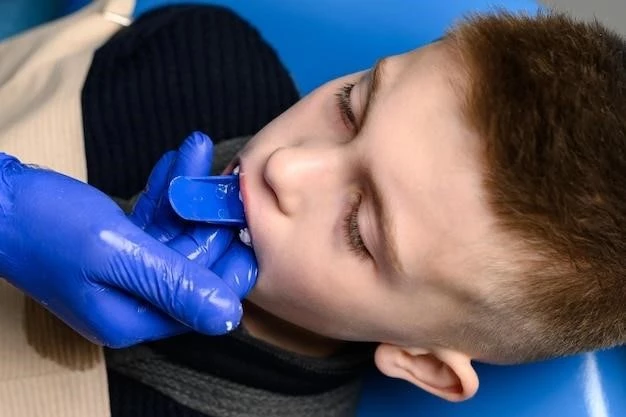Overview of Microbrachycephaly Ptosis Cleft Lip Syndrome
Disease⁚ Microbrachycephaly Ptosis Cleft Lip Syndrome
In the context of the syndrome, individuals may present with a cluster of distinctive physical and developmental features. These could include microbrachycephaly, intellectual deficits, palpebral ptosis, and cleft lip abnormalities. The combination of these characteristics defines the Microbrachycephaly Ptosis Cleft Lip Syndrome.
Research and documentation have highlighted the complexity of this syndrome, emphasizing the need for specialized care and interventions tailored to the unique needs of affected individuals. Understanding the underlying genetic basis and clinical manifestations is crucial in providing comprehensive support and management strategies for patients and their families.
Definition and Description
The syndrome, also known as Richieri Costa-Guion Almeida-Ramos syndrome, is characterized by a combination of microbrachycephaly, palpebral ptosis, hypotelorism, a thin/long face, and cleft lip abnormalities. It has been identified in individuals with intellectual deficits and anomalies affecting various body structures, including lumbar vertebrae and sacrum. Transmission is suggested to follow an autosomal recessive pattern.

Clinical Features of Microbrachycephaly Ptosis Cleft Lip Syndrome
The syndrome may present with a combination of short stature, mental retardation, microbrachycephaly, palpebral ptosis, coloboma of iris and retina, strabismus, malar hypoplasia, and cleft lip abnormalities. Additionally, intellectual deficits and anomalies affecting major organs have been observed.
Physical Characteristics
The physical characteristics of the Microbrachycephaly Ptosis Cleft Lip Syndrome include short stature, microbrachycephaly, palpebral ptosis, coloboma of iris and retina, strabismus, malar hypoplasia, and cleft lip abnormalities. Additionally, individuals may exhibit intellectual deficits and anomalies impacting various body structures like the lumbar vertebrae and sacrum.
Associated Anomalies
Individuals with the syndrome may also present with anomalies affecting major organs such as the brain, eyes, heart, kidneys, liver, pancreas, intestines, and genitalia. These anomalies can further impact the overall health and development of individuals with the Microbrachycephaly Ptosis Cleft Lip Syndrome.
Causes and Transmission of the Syndrome
The Microbrachycephaly Ptosis Cleft Lip Syndrome is suggested to have an autosomal recessive pattern of transmission. The condition is characterized by a complex interplay of genetic factors resulting in distinctive physical and developmental features observed in affected individuals.
Genetic Basis
The genetic basis of the Microbrachycephaly Ptosis Cleft Lip Syndrome involves a complex interaction of genetic factors resulting in the characteristic features observed in affected individuals. The syndrome is believed to follow an autosomal recessive inheritance pattern, emphasizing the contribution of specific genetic variations in its development.
Autosomal Recessive Inheritance
The transmission of the Microbrachycephaly Ptosis Cleft Lip Syndrome appears to follow an autosomal recessive pattern, indicating that both parents carry and pass on a copy of the mutated gene responsible for the syndrome. This mode of inheritance highlights the genetic complexity associated with the syndrome.
The diagnosis of the Microbrachycephaly Ptosis Cleft Lip Syndrome involves clinical evaluation and genetic testing. Clinicians assess physical characteristics and may use genetic tests to confirm the presence of specific mutations associated with the syndrome.

Diagnosis and Screening for Microbrachycephaly Ptosis Cleft Lip
Clinicians diagnose the Microbrachycephaly Ptosis Cleft Lip Syndrome through clinical evaluation, assessing physical characteristics such as short stature, microbrachycephaly, palpebral ptosis, coloboma of iris and retina, and cleft lip abnormalities. Confirmatory genetic testing may be conducted to identify specific mutations associated with the syndrome.
Genetic Testing
Genetic testing plays a crucial role in confirming the presence of specific mutations associated with the Microbrachycephaly Ptosis Cleft Lip Syndrome. This testing helps clinicians identify the underlying genetic factors contributing to the development of the syndrome, aiding in accurate diagnosis and personalized treatment approaches.
Treatment Options for Individuals with the Syndrome
Treatment for the Microbrachycephaly Ptosis Cleft Lip Syndrome may involve surgical interventions to address physical abnormalities like cleft lip and palate. Additionally, management of associated health issues is essential for comprehensive care.
Surgical Interventions
Surgical interventions play a crucial role in addressing physical abnormalities such as cleft lip and palate in individuals with the Microbrachycephaly Ptosis Cleft Lip Syndrome. These surgeries aim to correct structural defects and improve both aesthetic appearance and functional outcomes for affected individuals.
Management of Associated Health Issues
The Microbrachycephaly Ptosis Cleft Lip Syndrome requires comprehensive management of associated health issues that may affect major organs such as the brain, eyes, heart, kidneys, liver, pancreas, intestines, and genitalia. It is essential to provide holistic care to address the diverse health challenges experienced by individuals with this syndrome.
Support and Resources Available for Patients and Families
Communities and advocacy groups provide support for individuals with Microbrachycephaly Ptosis Cleft Lip Syndrome. These groups offer valuable information, emotional support, and insights into navigating life with the syndrome. Specialist healthcare providers offer tailored care and expertise in managing this complex condition.
Community Groups and Advocacy Organizations
Community groups and advocacy organizations play a vital role in supporting individuals and families affected by Microbrachycephaly Ptosis Cleft Lip Syndrome. These groups offer a platform for sharing experiences, providing emotional support, and raising awareness about the syndrome within the community.
Specialist Healthcare Providers
Specialist healthcare providers play a critical role in the diagnosis and management of Microbrachycephaly Ptosis Cleft Lip Syndrome. These knowledgeable professionals have expertise in the syndrome, conduct research, and offer specialized care to individuals and families affected by this complex condition.
Research and Ongoing Studies on Microbrachycephaly Ptosis Cleft Lip Syndrome
Current research initiatives focus on understanding the genetic basis and associated anomalies of Microbrachycephaly Ptosis Cleft Lip Syndrome. Collaboration with specialists and institutions aims to advance knowledge and treatment options for individuals affected by this complex condition.
Current Research Initiatives
Current research initiatives focus on understanding the genetic basis and associated anomalies of Microbrachycephaly Ptosis Cleft Lip Syndrome. Collaboration with specialists and institutions aims to advance knowledge and treatment options for individuals affected by this complex condition.
Collaboration with Specialists and Institutions
Specialists and institutions collaborate to advance research and treatment options for individuals with Microbrachycephaly Ptosis Cleft Lip Syndrome. By pooling expertise and resources, these collaborations aim to improve understanding and outcomes for those affected by this condition.
Impact of the Syndrome on Daily Life and Well-being
The Microbrachycephaly Ptosis Cleft Lip Syndrome can have profound psychological and social implications, impacting the individual’s well-being and overall quality of life. Educational and developmental challenges may arise, necessitating tailored support and interventions to enhance the daily life of affected individuals.
Psychological and Social Implications
Individuals with Microbrachycephaly Ptosis Cleft Lip Syndrome may face psychological and social challenges due to the visible physical abnormalities associated with the condition. These implications can impact self-esteem, social interactions, and overall well-being, requiring targeted support and interventions to address these aspects of daily life.
Educational and Developmental Challenges
Individuals with Microbrachycephaly Ptosis Cleft Lip Syndrome may face educational and developmental challenges due to the complex nature of the condition. Tailored support and interventions are necessary to address these challenges and promote optimal development and learning outcomes.
Global Awareness and Advocacy Efforts for Microbrachycephaly Ptosis Cleft Lip Syndrome
International initiatives and awareness campaigns aim to enhance understanding and support for individuals with Microbrachycephaly Ptosis Cleft Lip Syndrome. These efforts promote global awareness, advocacy, and collaboration to improve outcomes for affected individuals.
International Initiatives
International efforts focus on enhancing awareness and understanding of Microbrachycephaly Ptosis Cleft Lip Syndrome. Collaborations aim to promote advocacy, education, and support for individuals and families affected by this condition on a global scale.
Awareness Campaigns and Events
Awareness campaigns and events are essential to educate individuals and communities about Microbrachycephaly Ptosis Cleft Lip Syndrome. These initiatives aim to increase understanding, support advocacy efforts, and foster a more inclusive environment for individuals living with the condition.
Future Prospects and Advances in Treating Microbrachycephaly Ptosis Cleft Lip Syndrome
Emerging therapies and research directions aim to improve the management and outcomes for individuals with Microbrachycephaly Ptosis Cleft Lip Syndrome. Early detection and intervention play a crucial role in enhancing the prognosis and quality of life for affected individuals.
Emerging Therapies and Research Directions
The information generated on the Internet provides insights into the features and characteristics of the Microbrachycephaly Ptosis Cleft Lip Syndrome. The syndrome is characterized by a combination of unique physical features such as microbrachycephaly, palpebral ptosis, coloboma of iris and retina, malar hypoplasia, and cleft lip abnormalities. Individuals with the syndrome may also experience intellectual deficits and anomalies affecting major organs like the brain, eyes, heart, and kidneys. Genetic testing is crucial for confirming specific mutations associated with the syndrome. Treatment may involve surgical interventions to address physical abnormalities and the management of associated health issues. Global awareness and advocacy efforts aim to enhance understanding and support for affected individuals on an international scale.
The provided information showcases a comprehensive understanding of the syndrome’s clinical features, genetic basis, and the impact it has on individuals’ daily lives. Additionally, it highlights the importance of research, collaboration with specialists, and advancements in treatment options to improve outcomes for those affected by the syndrome.
Importance of Early Detection and Intervention
The Internet information on the disease highlights the unique features of Microbrachycephaly Ptosis Cleft Lip Syndrome, including physical characteristics such as microbrachycephaly, palpebral ptosis, coloboma of iris and retina, malar hypoplasia, and cleft lip abnormalities. The detailed descriptions emphasize the complexity and varied manifestations of the syndrome, with individuals potentially experiencing intellectual deficits and anomalies in major organs such as the brain, eyes, heart, and kidneys. The condition is identified through clinical evaluations and genetic testing, which play essential roles in confirming specific mutations associated with the syndrome. Surgical interventions are recommended to address physical abnormalities like cleft lip and palate, along with comprehensive management of associated health issues. Global awareness efforts and advocacy seek to increase understanding and support for individuals and families affected by this syndrome.
